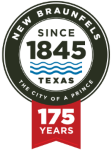Timeline
The first 30 years of New Braunfels, Texas: 1842–1872
A group of 21 German aristocrats came together at Biebrich on the Rhine near Mainz, Germany, to form an organization known as the Adelsverein, or “Society”—short for Society for the Protection of German Immigrants in Texas. The first four ships to set sail left Germany in the fall of 1844 and the last arrived on Dec. 21, 1844.
Prince Carl Solms-Braunfels landed at Galveston to locate property for settlers that followed later. Lipan, Tonkawa, Karankawa, and Hueco Indians were in the area at the time of founding.
After securing a landing site on the Texas Coast at what was then known as Carlshafen (now Indianola), Prince Carl returned to San Antonio where he heard of available land situated on the Comal and Guadalupe rivers, and of the legend of Las Fontanas (Comal Springs).
Prince Carl entered into an agreement with Maria Antonia Veramendi Garza and her husband for the purchase of 1,265 acres for $1,112. This included the present site of New Braunfels.
Prince Carl crossed the Guadalupe River at the ford of the military road, El Camino Real, which stretched from Nacogdoches to San Antonio.
On Good Friday, emigrant wagons forded the river at the same spot as Prince Carl, marking the founding of New Braunfels.
The cornerstone was laid for a fort—the Sophienburg—named in honor of the prince’s fiancée, the Lady Sophia, Princess of Salm-Salm.
Hermann Seele began the city’s first school under the same elm trees where Reverend Ervenberg held Christian services.
The First Protestant Church was incorporated.
The first ferry across the Guadalupe River was established at the confluence of the Comal and Guadalupe rivers. The ferry was able to handle all but the heaviest flood waters and claimed to be able to carry the heaviest wagons.
Ernst and Antoinette Gruene arrived in Galveston.
Comal County was created by the Texas Legislature.
The first Catholic mass was held, and land was given for a structure to be built.
Kindermasken Ball was founded by Hermann Seele.
Dr. Ferdinand Lindheimer began collecting and studying flora in Texas. He organized his findings into a system, thus becoming known as the “Father of Texas Botany.”
Artist Conrad Casper Rohrdorf created first panoramic view of New Braunfels.
Black Walnut Church was built for the Catholic Church.
The New Braunfels Schuetzen Verein was founded. It is the oldest continuously active shooting club in the United States.
New Braunfels was the fourth largest city in Texas.
Carl G. von Iwonski opens first art studio, where he depicted portraits of early settlers in ink, oil, and pencil.
St. Martin’s Lutheran Church was founded. It is now the oldest Lutheran church in Texas.
The area’s first singing society formed – Germania Gesangverein.
A large meeting of interested New Braunfels residents elected Ferdinand Lindheimer as the newspaper’s first editor from a list of three candidates. The money for purchase of the equipment was subscribed publicly, and each subscriber received a certificate of partnership.
The Agricultural and Horticultural Society of Comal County was founded by the Acker und Gartenbau Verein.
The Shepherd’s Society was formed, representing cattle grazing and herding.
The first issue of the Neu Braunfelser Zeitung was published.
Lindheimer, a botanist who had no training in the newspaper business, became the sole owner of the Zeitung.
The first wagon bridge across the Comal River was built by the City of New Braunfels.
Henne Hardware opened and has been operating ever since. It is the oldest hardware store in Texas.
The first public school was founded and funded through self-imposed tax. Citizens unanimously voted to impose the tax, 18 years before the State of Texas provided for such taxation.
Original county facility built.
Naegelin’s Bakery opened and has been operating continuously ever since. It is now the oldest bakery in Texas.
The first generation German-American farmer Heinrich (Henry) D. Gruene purchased 6,000 acres of farmland three miles north of New Braunfels, along the Guadalupe River.
